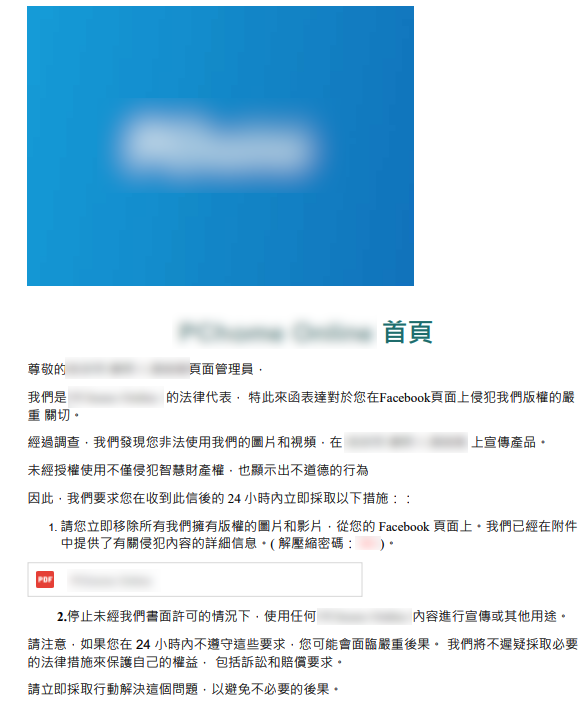- Cisco Talos has observed an unknown threat actor conducting a phishing campaign targeting Facebook business and advertising account users in Taiwan.
- The decoy email and fake PDF filenames are designed to impersonate a company's legal department, attempting to lure the victim into downloading and executing malware.
- This campaign abuses Google's Appspot[.]com domains, a short URL and Dropbox service, to deliver an information stealer onto the target's machine to avoid network security product detections.
- Talos also observed the threat actor using multiple techniques to evade antivirus detection and sandbox analysis, such as code obfuscation, shellcode encryption, hiding malicious code in resource data to expand the file size to over 700 MB, and embedding LummaC2 or Rhadamanthys information stealers into legitimate binaries.
Phishing email campaign targets Taiwan

Talos observed an unknown threat actor conducting a malicious phishing campaign targeting victims in Taiwan since at least July 2024. The campaign specifically targets victims whose Facebook accounts are used for business or advertising purposes.
The initial vector of the campaign is a phishing email containing a malware download link. The phishing email uses traditional Chinese in decoy templates and the fake PDF files, suggesting the target is likely traditional Chinese speakers. Some of the fake PDF filenames that we observed during our analysis are:
- IMAGE COPYRIGHTED.exe
- [Redacted] 的影片內容遭到侵犯版權.exe (translates to “[Redacted]'s video content has been copyright infringed.exe”)
- 版權侵權信息- [Redacted] Media Co Ltd.exe (translates to “Copyright Infringement Information – [Redacted] Media Co Ltd.exe”)
- 版權侵權信息- [Redacted] Media Group Inc.exe (translates to “Copyright Infringement Information – [Redacted] Media Group Inc.exe”)
- 版權侵權信息- [Redacted] Technology Group.exe (translates to “Copyright Infringement Information – [Redacted] Technology Group.exe”)
- 版權侵權信息- [Redacted] Co. Ltd.exe (translates to “Copyright Infringement Information – [Redacted] Co. Ltd.exe”)
- [Redacted] Online -宣布侵權.exe (translates to “[Redacted] Online – declare infringement.exe”)
The decoy email and fake PDF filenames are designed to impersonate a company's legal department, attempting to lure the victim into downloading and executing malware. Another observation we found is that the fake PDF malware uses the names of well-known technology and media companies in Taiwan and Hong Kong. This provides strong evidence that the threat actor conducted thorough research before launching this campaign.
Additionally, we observed two phishing emails masquerading as notices from a well-known industrial motor manufacturer and a famous online shopping store in Taiwan. The emails claim that the company’s legal representatives have issued a notice to a Facebook page administrator alleging copyright infringement due to the unauthorized use of their images and videos for product promotion. The emails demand the removal of the infringing content within 24 hours, cessation of further use without written permission, and warn of potential legal action and compensation claims for non-compliance. Last but not least, with these two emails, we can easily identify that the threat actor uses the same template with minor modifications, such as changing the company name, legal department information, address, and website.

Phishing email impersonating a well-known industrial motor manufacturer.

Phishing email impersonating a famous online shopping store.
Attribution
Talos observed an unknown image printing file within the encrypted archive, with the filename "Support." Based on the file name and file size, it is likely that all encrypted archives we found on VirusTotal, which we have not been able to decrypt, contain the same EPS files inside. Pivoting off the EPS file metadata and its preview image on a search engine, we found an identical image with the same file name on a Vietnamese-language website. However, there is no strong evidence that it was created by an author from that region.

Support EPS file metadata.

The support EPS file preview image in this campaign (left) and the image we found from the internet (right).
Actor infrastructure
The threat actor is abusing Google's Appspot.com domains, a short URL and Dropbox service, to deliver an information stealer onto the target's machine. Appspot.com is a cloud computing platform for developing and hosting web applications in Google-managed data centers. When the victim clicks on the download link, it initially connects to Appspot.com, then redirects to a short URL created by a third-party service, and finally redirects to Dropbox to download the malicious archive. The actor is using the third-party data storage service as a download server to deceive network defenders.

Malware download link.
We also discovered that the actor is using multiple command and control (C2) domains in the campaign. The DNS requests for the domains during our analysis period are shown in the graph, indicating the campaign is ongoing.

C2 domain DNS requests.
Malware infection summary
The infection chain begins with a phishing email containing a malicious download link. When the victim downloads the malicious RAR file, they will need a specific password to extract it, revealing a fake PDF executable malware and an image printing file. Once the malware is decrypted and the fake PDF executable is run, it will execute the embedded LummaC2 or Rhadamanthys information stealer, which then collects the victim’s credentials and data, sending them back to the C2 server.

The malicious RAR file usually contains a fake PDF executable malware and an image printing file, but we observed a few malicious RAR files that contain an additional DLL file. However, without the correct password, we are not able to extract the malicious RAR file and analyze it.

The RAR file contains a fake PDF and an image printing file.

The RAR file contains a fake PDF, an image printing file, and additional DLL file.
The fake PDF executable malware variant was delivered as a payload in this campaign. This malware will embed LummaC2 or Rhadamanthys information stealers into legitimate binary and the legitimate binary including iMazing Converter, foobar2000, Punto Switcher, PDF Visual Repair, LedStatusApp, and PrivacyEraser. Below shows one of the file details of the fake PDF executable.

Fake PDF file detail information.
LummaC2 stealer and its loader
LummaC2 Stealer is a type of malware designed to exfiltrate sensitive information from compromised systems. It can target system details, web browsers, cryptocurrency wallets, and browser extensions. Written in C, this malware is sold on underground forums. To avoid detection and analysis, it employs various obfuscation methods. The malware connects to a C2 server to receive instructions and transmit the stolen data.
The loader for LummaC2 changes the execution flow of the binary malware, causing it to invoke an unknown library to execute the malicious code functions. This strategic modification complicates detection and analysis efforts. Once these malicious functions are invoked, the malware utilizes the CreateFileMappingA API to write the payload into a mapped memory block, effectively hiding it within the system's memory. After successfully mapping the payload, the malware then executes it.

Call to an unknown library to execute the malicious code functions.
When the malware begins executing the shellcode in memory, it first decrypts the second half of the program block, which contains part of the shellcode loader and the LummaC2 malware execution file. Once the decryption is complete, it will call the VirtualAllocate API to allocate a memory block, write the information stealer's execution file to that block, and then execute it.

Jump code to shellcode block.
|
|
|
Encrypted shellcode (left side) and decrypted shellcode (right side).
We also collected all of the build IDs of the LummaC2 in this campaign and below are the screenshots of the LummaC2 stealer alert message box and its POST message.

Alert message shown to the user when executing LummaC2.

POST message with act=life and url path /api.
Build ID:
- sTDsFx–Socks
- iAlMAC–ghost
Rhadamanthys stealer and its loader
Rhadamanthys is a sophisticated information stealer that emerged in 2022 and is sold on underground forums. This comprehensive stealer malware is capable of gathering system information, credentials, cryptocurrency wallets, browser passwords, cookies, and data from various other applications. It employs numerous anti-analysis techniques, complicating analysis efforts and hindering its execution in sandbox environments.
We observed the Rhadamanthys loader in this campaign contains 10 sections in its binary structure. Despite the presence of multiple sections, the threat actor specifically targets the .rsrc section to insert the malicious code. This section is heavily obfuscated to conceal the malicious activities and make analyses more challenging. The choice of the .rsrc section is strategic, as it is typically associated with resource data like icons and menus, making it less likely to raise immediate suspicion.

The loader of Rhadamanthys binary structure sections.
After analysis, we discovered that the Rhadamanthys loader employs several sophisticated techniques to ensure its persistence and evasion. Initially, the loader copies itself and writes the file to “C:Users[user]DocumentslumuiUpdaterffUpdaar.exe”. In order to avoid detection by antivirus programs and sandbox environments, it expands the file size to over 700 MB. This significant increase in file size is intended to bypass heuristic and signature-based detection mechanisms commonly used by security products, which may struggle to process such large files effectively.

The loader copies itself to the lumuiUpdater folder.
Furthermore, the loader is configured to start automatically by modifying the Windows Registry. It writes an entry to “HKEY_CURRENT_USERSoftwareMicrosoftWindowsCurrentVersionRun” and key name value “sausageLoop”, a registry key that specifies programs to be launched during the system startup. This registry modification ensures that the malicious loader is executed every time the victim's computer restarts, thereby maintaining its persistence on the infected system.

The loader is configured to start automatically.
Finally, the loader executes the legitimate system process "%Systemroot%system32dialer.exe" and injects Rhadamanthys' payload into it. This process injection technique allows the malware to run its malicious code within the context of a legitimate system process, further evading detection. Additionally, it uses mutex objects to ensure that only one instance of the malware runs on the infected host. Below is the list of mutex names we observed in this campaign, which has also been disclosed in previous reporting by other.
- GlobalMSCTF.Asm.{04fb3f26-9d18-66b5-6862-7b8a85e4b620}
- Session1MSCTF.Asm.{04fb3f26-9d18-66b5-6862-7b8a85e4b620}
- Session2MSCTF.Asm.{04fb3f26-9d18-66b5-6862-7b8a85e4b620}
- Session3MSCTF.Asm.{04fb3f26-9d18-66b5-6862-7b8a85e4b620}
- Session4MSCTF.Asm.{04fb3f26-9d18-66b5-6862-7b8a85e4b620}
- Session5MSCTF.Asm.{04fb3f26-9d18-66b5-6862-7b8a85e4b620}
- Session6MSCTF.Asm.{04fb3f26-9d18-66b5-6862-7b8a85e4b620}
- Session7MSCTF.Asm.{04fb3f26-9d18-66b5-6862-7b8a85e4b620}
- Session8MSCTF.Asm.{04fb3f26-9d18-66b5-6862-7b8a85e4b620}
Coverage

Cisco Secure Endpoint (formerly AMP for Endpoints) is ideally suited to prevent the execution of the malware detailed in this post. Try Secure Endpoint for free here.
Cisco Secure Web Appliance web scanning prevents access to malicious websites and detects malware used in these attacks.
Cisco Secure Email (formerly Cisco Email Security) can block malicious emails sent by threat actors as part of their campaign. You can try Secure Email for free here.
Cisco Secure Firewall (formerly Next-Generation Firewall and Firepower NGFW) appliances such as Threat Defense Virtual, Adaptive Security Appliance and Meraki MX can detect malicious activity associated with this threat.
Cisco Secure Malware Analytics (Threat Grid) identifies malicious binaries and builds protection into all Cisco Secure products.
Umbrella, Cisco's secure internet gateway (SIG), blocks users from connecting to malicious domains, IPs and URLs, whether users are on or off the corporate network. Sign up for a free trial of Umbrella here.
Cisco Secure Web Appliance (formerly Web Security Appliance) automatically blocks potentially dangerous sites and tests suspicious sites before users access them.
Additional protection with context to your specific environment and threat data are available from the Firewall Management Center.
Cisco Duo provides multi-factor authentication for users to ensure only those authorized are accessing your network.
Open-source Snort Subscriber Rule Set customers can stay up to date by downloading the latest rule pack available for purchase on Snort.org. Snort SIDs for this threat are 64167-64169.
IOC
IOCs for this research can also be found at our GitHub repository here.




Leave a Reply